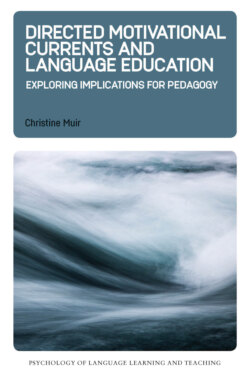Читать книгу Directed Motivational Currents and Language Education - Christine Muir - Страница 9
На сайте Литреса книга снята с продажи.
ОглавлениеPart 1: Introducing DMCs and Intensive Group Projects
Part 1 both sets the scene and lays the groundwork for the research and findings that I go on to present throughout this book. I begin in Chapter 1 by situating DMCs within the wider context of L2 motivation and second language acquisition (SLA) research. The field of SLA has adopted several significant new perspectives since the turn of the 21st century, each contributing its own account in the overall story tracing the path towards the emergence of DMCs. Rather than offering a detailed narrative of the development of L2 motivation research as a whole, in Chapter 1 I focus on a curated selection of key areas of inquiry. These specific areas of interest are included because they are most relevant both to understanding and situating DMCs in a wider context, and also to the empirical studies I introduce in Parts 2 and 3 of this book. I overview the adoption of a complexity perspective and the reframing of our understanding of L2 motivation in terms of the self, before briefly reviewing key findings related to language learner self-concept, emotions and several areas of group-level investigation. I conclude Chapter 1 by tracing the emergence of DMCs and by underlining their wider significance.
Although summaries and descriptions of DMCs can be found elsewhere (for a recent, concise summary see Henry, 2019), this book would not be complete without offering its own. Chapter 2 presents a full overview of the DMC framework, highlighting all key elements of DMCs, including their goal-orientedness, launch, structure, positive emotionality and the way in which they come to an end. In Chapter 3, I continue this discussion further, simultaneously rooting the narrative in the context of language teaching and learning. In doing so, this demands that the focus of discussion be broadened to include the notion of group DMCs. Group DMCs are of disproportionate importance in the context of language learning, owing to the simple fact that instructed second language acquisition (ISLA) primarily takes place with groups of learners. In classroom contexts, we have argued that DMCs can best be understood as emerging through intensive group projects (IGPs) (Dörnyei et al., 2016). After more thoroughly introducing ‘projects’ and exploring their alignment with other pedagogical approaches, I overview key differences between individual and group DMCs and highlight essential principles with regards to designing intensive group projects (significantly, intensive group projects ‘with DMC potential’).
In the Part 1 summary that follows, I bring these ideas together and explore key areas in which future research is required – in order to develop both our theoretical and pedagogical understanding of DMCs. In doing so, I concurrently foreground the focus and aims of Parts 2 and 3 to follow.
